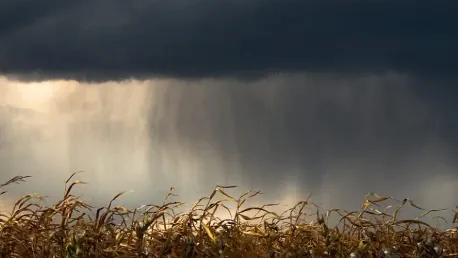The article titled “Did Climate Change Amplify Hurricane Helene’s Intense Rainfall?” delves into the factors that contributed to the extreme rainfall experienced during Hurricane Helene, particularly the influence of climate change. This topic is examined through the perspective of David Easterling, a NOAA climate scientist who experienced the storm firsthand. Easterling, who was personally impacted by the storm, is actively participating in efforts to understand the role global warming played in this significant weather event. His account provides a unique lens through which to explore the broader implications of Helene’s heavy rainfall and the potential influence of a warming planet.
Personal Account and Initial Reaction
David Easterling recounts his personal experience with Hurricane Helene through the lens of professional expertise and personal proximity. Initially, Easterling underestimated the severity of the forecasted rainfall; it wasn’t until the flooding began that the true impact of the storm became apparent. This personal narrative serves as a compelling entry point to delve into the wider-reaching effects of Helene’s rainfall. The experience underscores the unpredictable nature of such extreme weather events and heightens the urgency of understanding the influencing factors behind them. Easterling recorded an astonishing 15 inches of rainfall in his backyard, while other areas were not as fortunate, experiencing over 30 inches in just 72 hours. These staggering figures highlight the dramatic increase in rainfall severity, which is central to the analysis of the storm’s impact.
The severe flooding experienced during Hurricane Helene raises critical questions about the role climate change might play in magnifying such intense weather phenomena. Easterling’s personal encounter with the storm’s aftermath adds a human element to the otherwise data-driven discourse on global warming and its potential effects. This narrative not only personalizes the broader climate discussion but also sets the stage for a more nuanced examination of the scientific and environmental factors that contributed to the scale of Helene’s rainfall.
Climate Attribution Studies
Climate scientists, including Easterling, are tasked with analyzing data to discern the extent to which climate change may have amplified the rainfall during Hurricane Helene. A substantial aspect of this analytical effort is manifest in a climate attribution study conducted by the World Weather Attribution (WWA) initiative. This study concluded that Helene’s rainfall totals were, indeed, 10% heavier because of climate change. While hurricanes and tropical storms themselves cannot be solely attributed to the phenomenon of climate change, the side effects—such as increased rainfall—are areas where the influence of a warming planet becomes evident. Findings from such studies suggest a prevailing trend in which warmer atmospheric conditions lead to more intense rainfall during storms.
These revelations underscore the importance of understanding climate change’s role in extreme precipitation events. The analysis points to a broader consensus among scientists that such events are becoming both more frequent and more intense as a direct result of global warming. This conclusion aligns with earlier scientific forecasts and invites an imperative discussion on the need for adaptive strategies. The insights drawn from studies like those by WWA are pivotal in informing the development of policies and infrastructure designed to mitigate the impact of future extreme weather events.
Sea Surface Temperatures
Exceptionally high sea surface temperatures in the Gulf of Mexico during Helene played a critical role in intensifying the storm’s severity. These higher temperatures provided additional heat and moisture, essential ingredients that contributed to the deluge. The interconnection between sea surface temperatures and storm intensity underscores the broader climate trends and their role in shaping extreme weather phenomena. Such conditions create a scenario where the atmosphere holds more moisture, resulting in heavier rainfall during storms like Helene. This observable pattern is tied to broader shifts in Earth’s climate, driven by increased concentrations of greenhouse gases in the atmosphere.
Scientists have generally agreed that climate change, through elevated sea surface temperatures, is making severe precipitation events more probable and severe. This finding stresses the necessity for strategies aimed at adapting to such changing conditions. The consensus among the scientific community emphasizes that action must be taken to reduce the detrimental effects of these trends. It is increasingly evident that adaptive measures, such as enhancing forecast precision and constructing more resilient infrastructure, are needed to cope with the likely rise in extreme weather events.
Orographic Precipitation in Appalachians
The Southern Appalachian region’s topography played a significant role in exacerbating the rainfall during Hurricane Helene through a process known as orographic precipitation. This effect emphasizes the inherent vulnerability of certain regions to amplified flood risks when heavy rainfall occurs. The phenomenon elevates concerns about regional susceptibility and highlights the importance of understanding local geographical interactions with climatic factors. Mountainous areas like the Appalachians routinely experience intensified precipitation due to their elevations, which force moist air upwards, cooling it and causing it to condense into rainfall more efficiently compared to lower areas.
Both the WWA study and Easterling concur that climate change has indeed contributed to higher rainfall totals, although there is ongoing debate regarding the precise magnitude of this contribution. The 10% increase in rainfall provided by the WWA study is indicative of the significant yet complex influence of climate change. This acknowledgment of broader environmental impacts pinpoints a trend that must be monitored closely, with much emphasis placed on improved methodologies to assess climatic impacts accurately on specific geographic locales.
Policy and Infrastructure Adaptation
There is an emerging trend towards leveraging analytical insights from climate studies to inform policy and infrastructure design, aiming to foster resilience against future climate-induced extreme weather events. Easterling’s insights underline the necessity for precise and robust statistical data to guide such pivotal decisions effectively. The practical implications of these analyses are far-reaching, directly influencing how societies prepare for and respond to the evolving challenges posed by a warming climate. This proactive approach underscores the critical need for adaptive strategies that accommodate the shifting landscape of weather phenomena.
The article also points to the necessity of technological and policy interventions to alleviate pressures on the climate system. These interventions encompass a range of actions such as improving forecasting precision, constructing better infrastructure, and implementing greener policies designed to reduce greenhouse gas emissions. The urgency for such measures is heightened by the growing body of evidence linking climate change with increased intensity of extreme weather events, particularly heavy rainfall. The data-driven narrative invites policymakers and infrastructure planners to adopt scientifically grounded approaches to safeguarding communities against the looming threat of climate-related disasters.
Criticism of Attribution Studies
Criticism of climate attribution studies is highlighted in the discourse, particularly concerning their expedited publication processes that sometimes bypass traditional peer review. While these studies offer valuable and timely insights post-disaster, caution is advised to maintain credibility and scientific robustness. Experts like Easterling stress the importance of thorough and meticulous analysis to uphold the integrity of climate science. The expedited nature of some studies may compromise the depth of peer review, raising concerns about the accuracy and reliability of the findings presented.
Easterling specifically criticizes the WWA study for averaging data over an excessively broad area, potentially diluting the localized accuracy of the findings. This criticism underscores the need for refined methodologies capable of providing more precise assessments of climatic impacts on specific geographic locales. Addressing these critiques is vital for advancing the field of climate science, ensuring that conclusions drawn from such studies are both credible and actionable. The balance between providing timely insights and maintaining rigorous scientific standards remains a critical consideration in the realm of climate attribution studies.
Scientific Consensus and Objectivity
The article “Did Climate Change Amplify Hurricane Helene’s Intense Rainfall?” investigates the reasons behind the extraordinary rainfall during Hurricane Helene and examines climate change’s influence on this event. The article features insights from David Easterling, a NOAA climate scientist who personally experienced Hurricane Helene. Easterling is involved in current research aimed at understanding the link between global warming and the hurricane’s significant rainfall. His personal experience offers a valuable perspective to analyze the general effects of Helene’s rain and how global warming might have intensified it. Easterling’s involvement provides a unique viewpoint, emphasizing the importance of comprehending the broader implications of extreme weather events in the context of a warming planet. Through his firsthand account and scientific expertise, the article explores how the ongoing changes in climate could be contributing to increased storm severity, offering a more comprehensive understanding of these phenomena.









